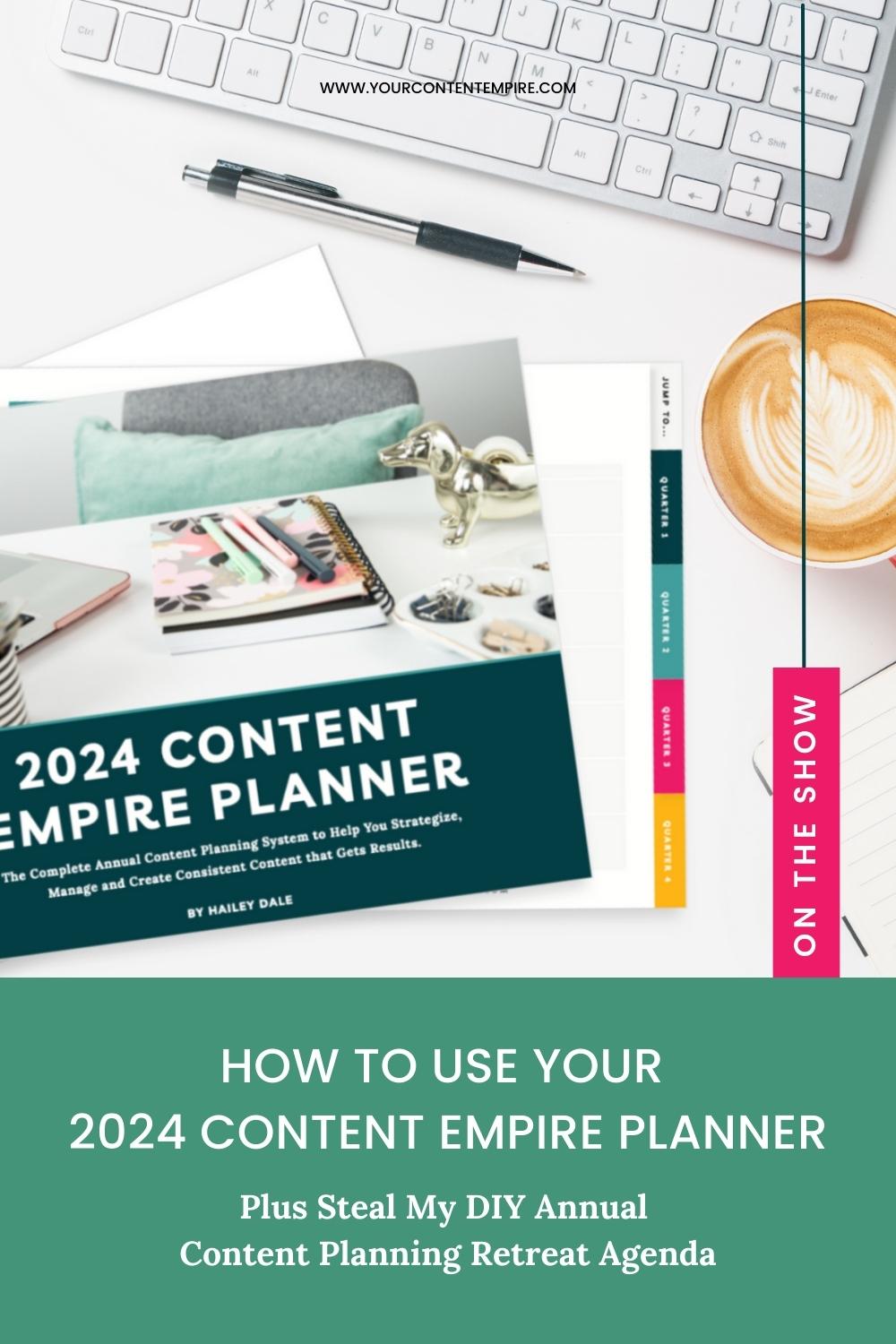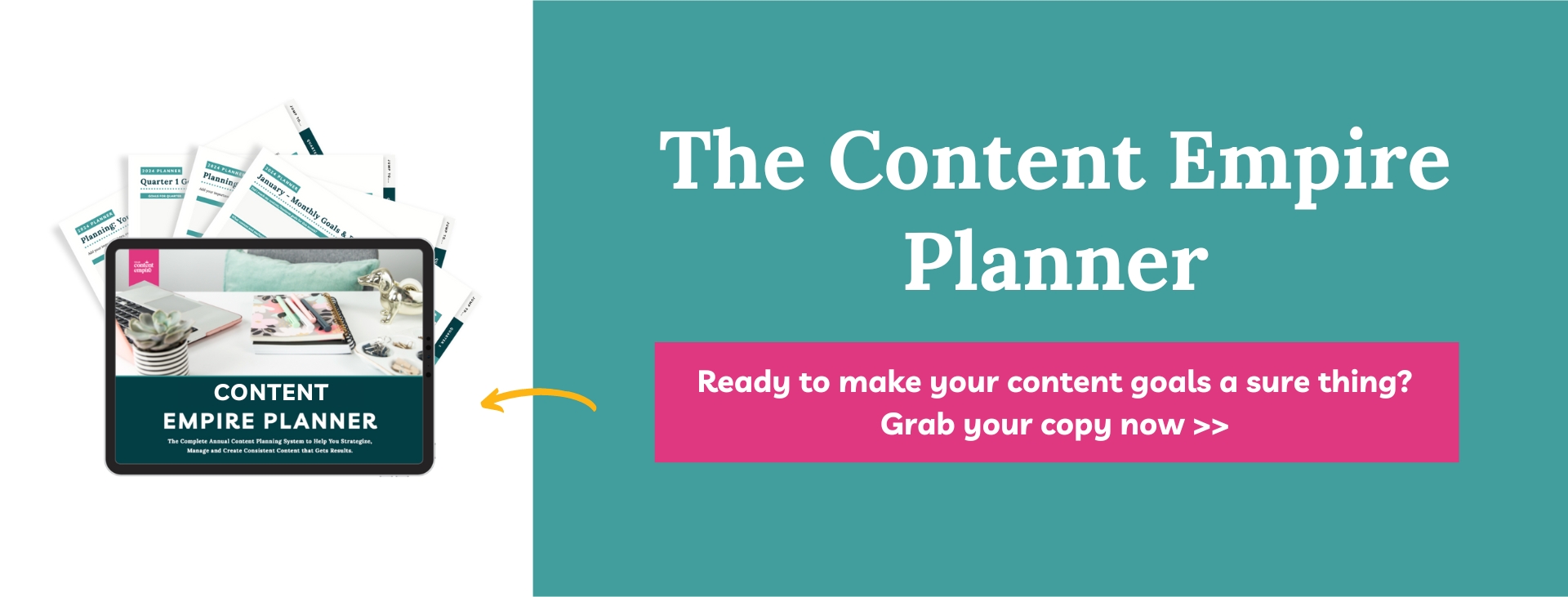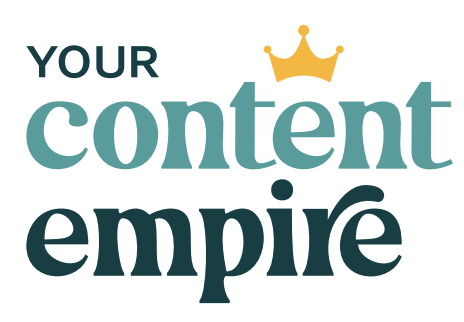Feeling overwhelmed by your yearly content planning? Say hello to the 2024 Content Planner!
I’m headed away in a couple of weeks for my annual business retreat (and biz-a-versary) to plan out the year ahead.
What makes this year extra special is that I’m bringing along a special friend…. a PRINTED version of the planner.
It’s a little something we’re testing out to see if people (other than me and my biz friends) want it before jumping into the deep end of printed planners officially.
In this week’s episodes, I’m giving you a play by play of my annual planning retreat agenda to inspire (or steal for) your own.
Here’s some highlights of what I’m covering…
- Yearly Business Review: Checking out website hits, social stats, the way we do things, team roles, and all about the money. (the nitty-gritty)
- Mapping Out the Next Big Year: Dreaming up money goals, planning content, events, and what's happening each month. (Basically, your roadmap.)
- Getting Organized with Keep-On-Track Tools:Making vision boards, listening to our vision audio, keeping an eye on progress using at-a-glance dashboards, tidying up our digital space, and picking out planners. (And setting aside planning times too!)
Other Links:
Wanna check out the 2024 Edition?
FULL TRANSCRIPT:
Welcome back to the Content Coffee Break podcast. Today's actually a really special episode because just yesterday I released the 2024 edition of the Content Empire Planner. And in addition to our digital planning bundle that we do every year with the Google Doc version, as well as the beautiful printed printable PDF version, we also did an actual printed version of the planner. So we're testing out a printed version of the planner too, to see if people want it. I ordered a couple for myself. I'm actually holding it right now. And it's so cool to have you holding a printed version of the planner. For my own upcoming biz-versary planning retreat, which is happening on our ninth business anniversary next month, this is the eighth year I've done the planner, and I just cannot wait to hear and see what people do with it. And this episode is a part of that equation as we're going to be going through the DIY planning retreat agenda that you can take with your Content Empire Planner and put it into action.
The other thing that is happening this week on the personal front, actually the day this episode goes live, is that I'm having an interior designer come. I signed up for an E-design package. And the perk of hiring someone locally, though, is that she can come and do it in person. It is a big deal for me. We just moved into the house last May, and so we've been here for over a year. And we've slowly been doing things like pottering along. We did a lot of work in the yard and the backyard, updating things, but we still have the main area—the kitchen, the dining room, the living room, the hallway—it's all one big room with an open concept. And we're having someone come and help us because, you know, I just don't know how I'm going to pull everything together. We have a ton of ideas. I'm changing my mind on colors every other day, and I just need someone to help bring it all together, pull it all together, and help us think through all those different pieces. My husband is also a woodworker who is obsessed with wood and all things wood. So I was telling her, I really want to avoid the space becoming the wood-on-wood-on-wood version of the Canadian tuxedo. I need some help bringing some balance, some softness, and some light into the space. And it's that element of bringing everything together that I need help with, which also reminds me of this planner and my intention for this planner. It is that external structure that helps organize your ideas, bringing all your thoughts and all the pieces together and ensuring, you know, there's a right order of operations to everything. I'm just always amazed at everything that's happening in my life. And the things that I choose to talk about on this podcast, I just find parallels between the two things all the time.
So in this episode, I'm going to take you behind the scenes as I give you a DIY agenda for the planning retreat. This is very, very similar to the agenda that I follow every single year. I go away for my business anniversary in November, and I still vividly remember starting my business on a long weekend because I had time off from work and finally hitting publish nine years ago, way back when, on my first website and having that go live. I remember the nerves. I remember the shakes in my head. I was so nervous. It felt like such a big moment, and since it's a long weekend, it's also the perfect time to go away and do or do a mini staycation kind of planning retreat. And this year is no exception. I'm excited to bring that printed version of the planner with me.
And by the way, I have to majorly shout out Sarah Steckler. She has a course all about how to use Amazon KDP and put together a print-on-demand version of your planner and journal. I would highly recommend it if you're interested in doing a printed planner or journal but don't want to deal with the inventory, the printing, or the shipping, or don't know where to get started. It's a fantastic course. It takes you on a journey through printing, designing, and getting it ready for print, launching, and all those things. So just a huge shout out for her. She was such an integral resource to this process. We just had this idea a month ago, and things came together very, very quickly, largely thanks to her and her program. So, I'll make sure to link that in the show notes too. I'll make a note for myself.
So, before we dive into the DIY planning retreat, I quickly want to point out and talk about the differences between the digital bundle and the printed version of the content planner. The printed version of the planner is just the planner, right? And it's sold through Amazon. That just lets us do print-on-demand rather than having to deal with a ton of inventory and shipping. It is over 185 pages, broken down into our annual planning section, four quarterly sections, and within each quarter, there are three monthly planning sections. Then, within each month, there are two weekly sections for each week of the month of the year. So, the project planning section and the content planning for the week, you get that as well in the digital planning bundle. But in addition, you get two digital planners.
So, you get the PDF version of it, and the Google doc version, if that's your preference. Plus, in the digital bundle, you also get walkthroughs for each section, like the annual planning, the quarterly planning, and monthly planning walkthroughs, plus a ton of other content implementation resources like the content batching workflow and systems workshop, the repurposing recipes and walkthroughs, the CEO dashboard training and template. And the big one, you also get monthly content planning, accountability, and a new one is our quarterly planning workshops, just for people who buy the digital bundle.
So, if you're interested in checking out a version, head over to yourcontentempire.com/planner, and just keep in mind here that you could buy both, right? If you want to have all that support and all that walkthrough, it's at a very reasonable price point. And then you can add on the printed version. It's much, much cheaper than if you were to print all of those pages yourself and buying them. I think one year, I printed it out and it was over a hundred dollars to print out this thing in color. So, this is a much more affordable way to grab it.
Now, let's dive into the agenda for the DIY planning retreat. The planner, like I mentioned, is broken down into an annual planning section, quarterly sections, and monthly sections. But that first annual planning section is further broken down into two: there's a review for your annual section and the planning. So, looking backward and looking forward. In the review section, we are reviewing the past year and then using that information, those reflections, and the lessons from the past year, to come up with goal ideas and project ideas, as well as optimization tweaks that we want to do in the coming year. For your retreat, I would recommend having two to three days. Day one is all about the annual review. I pull the numbers, review, and audit my business using the planner. Day two is when I do the planning, setting my goals, intentions, breaking those goals down into project plans. From past experience, I know that as much as I want to work on all of my goals simultaneously, that is not possible.
I need to assign each goal a place and a time in my calendar. And I do this by using the cornerstone calendar found in the Content Empire Planner. Then, on day three, I create my implementation tools: my quarterly content plans, my vision board, my vision audio, cleaning up my content assets, and just everything I need to get ready to implement. I'm also creating a wrap-up plan for the rest of the year. What needs to happen between now and midnight on January 1st? What needs to get done? What is my wrap-up plan for the current year? And, if you don't have three days, you could squeeze it into two. It's also, I find, very helpful to spend an entire year or an entire day reviewing the past year, as I find it can be really tough to switch from review mode to forward-looking mode. However, you can also spread it out over three weeks and just do a couple of hours per day or on the weekends. Make this work for yourself. You can take this and tailor it to you. But when planning your retreat, I recommend that you try to find little ways to make it special for you. You could host it at home, have a little staycation at your kitchen table, barricade yourself in your bedroom so your family can't interrupt you, or your office. Or you could head to a local or not-so-local hotel or Airbnb to get some uninterrupted planning time. I've done all of these. I also like to make it special by having all of my favorite snacks, Post-its, pretty planner pens galore, and planning lots of recharge breaks like walks throughout the day, dinner, sometimes a massage or spa treatment to break up the day. We live on the west coast, so getting out to the ocean is a big part of my usual planning retreat repertoire, including lots of walks and nature breaks. Spend some time thinking about what would make this special and fun for you, as well as including some recharge time and brain breaks.
So, let's dive into what we're going to be doing each day, planning-wise, for each of the three days of the planning retreat. Day one is for review. And P.S., all of these sections are in the planner. We start by reviewing your 2023 goals. We want to look at all of your offers and what you sell, how many units of each one were sold, what was the average price point, and what were the total sales. A really important question here is, where did most of those sales come from? The whole point of this review is to identify what worked and what didn't work, looking at the numbers rather than just relying on our recollections. With that being said, we want to know where the sales came from as well. Were there any surprises with the offers? Do you want to potentially cut or add something for next year? Then, we look at your sales system. Did you have an evergreen sales system? Did you rely on launches, affiliates, referral programs, etc.? Did you have items on your website? Were you using Etsy? Did you rely on, or were most of your sales coming from, referrals? What happened with your sales system? Where did sales come from, and what do you want to change next year? Maybe you did all launches this year and next year you're thinking, “I want to do an evergreen automated sales system to supplement or complement the launches I'm doing, so I rely less on those live launches.” This is the time to review your sales system and think about the improvements and changes that you want to make for next year.
Then we shift into looking at your website traffic. So, total traffic, most popular pages, most popular blog posts, and traffic sources. You can also use this as an opportunity to see if your analytics are set up correctly. Right? And, Neil, close any gaps as well. Were there any surprises with traffic? Did it plateau, did it grow, did it increase, did it decrease? Why? What were the main traffic drivers, and what do you maybe want to shift next year to increase traffic or keep it steady?
Then we look at your social media: your platform, following, engagement, and joy score. How much you enjoyed that platform? And any other kind of qualitative results that maybe don't show up in the numbers. What worked? What didn't work? What do you want to start or stop doing? What do you want to do more of, less of? What needs a new system or strategy? We are just wrapping up your content, your empire. And we just finished with our systems for attraction and social media platforms. It's all about systems and strategies and trying something new every 90 days so you don't spread yourself too thin.
So, with this approach, you might also adopt a similar strategy where Q1 you're focused on Pinterest, Q2 you're focused on Instagram, and Q3 on Facebook ads, right? So, you don't need to implement all of these changes at once. We're just starting to note down some ideas.
Then, next we look at your brand. So, have you reviewed your brand guidelines? Conducted a review of your brand applications of those guidelines through your graphics and your website pages? How closely are you following those brand guidelines? Check in with those brand values. Are they still resonating with you and your audience? Make a note of any updates you want to make to the brand. So, this year, we're doing a big content cleanup, and we're going to be reviewing our brand templates and organizing everything so they're accessible.
So, review your website's pages next. Test your forms, ensuring that everything is functioning. Consider removing pages you no longer need. Complete an annual website maintenance. I have a bit of a checklist here: updating your copyright year, privacy policies, terms and conditions, cleaning out unused plugins (if you're on WordPress), making your updates, backing up your website, ensuring you have a site security plugin, and reviewing old users.
Then assess your 2023 customer experience and offer fulfillment. Look at how your main offers in your business are being delivered and evaluate the customer experience. What feedback do you get? What opportunities do you have to elevate it?
Review your 2023 systems, breaking them down into categories next. So, thinking about what are your content systems? What are your marketing systems, your offer fulfillment systems, admin, team CEO, and other? What worked this year with your systems and what didn't work this year? With your systems, what new systems do you need and which need updating?
Then consider your team. Was it just you, or did you have team members? If it is just you, instead of being like “I did all these things,” break your big solopreneur role into different roles, right? So, think about, “When I was wearing my graphic designer hat, what were the things I did? When I was wearing my copywriter hat, what were the things that I did?” This way, it helps you start to plan out. Maybe if you do want to hire or outsource one role, one of those roles, you can start thinking about what that would take off your plate.
Next, we look at finances. So, you want to make sure your bookkeeping is up to date for sure. And you know, if you're doing this in November or October, you might only do up to the past month, right? So, this might be at this current moment in time. And then, at the end of the year, you can come back and finish it. But what were your sales, expenses, profit, and tax estimate? Were there any financial surprises? Where did the majority of those sales and expenses come from, and what can you maybe cut expense-wise next year? Or what do you want to invest in?
Then, finally, we're getting near the end here. We review your 2023 goals. So, currently, where do they stand? What's their current status? What were they? Do you plan? What is your plan moving forward? Do you want to finish them this year, carry them into next year, start over, or abandon them? Sometimes, as the year progresses, right, we realize that some of the goals we planned on just really aren't as important as we initially thought. So, were there any unexpected goals that you didn't plan for that you achieved as well?
After reviewing your goals, we conduct an overall yearly reflection. So, we look at each month from January to December, or January to October if you're not finished the year yet, noting highlights, events, and lessons. One of the practices that I have in my business is a weekly measurement process, combined with a weekly business journal. And this helps me reflect on the past week's lessons, highlights, and lowlights, providing a comprehensive overview of the year that I can go back and look through and be like, “What was happening in January? What was happening in March?” Right? What were those highlights? What were those lowlights and lessons?
So, that is the final thing that we do on day one. Answering. I have five really powerful annual reflection questions that I use. And these are really helpful, especially if you're ending the year feeling somewhat disconnected from your business. I'm going to dedicate the entire next episode to those questions. So, stay tuned for those. But that's the end of day one. A big first day, and you'll definitely deserve a treat for finishing this one. So, I like to break it down and work in 90-minute to two-hour blocks, and then take a break. And then, at the end, have a big recharge, big rest, big treat, maybe go out for dinner or tacos. Whatever that happens to be for you.
Then, on day two, we start looking forward to the year ahead. I spend the first two hours of the day focused on goals. I like to start with a giant brain dump of everything I want to do in my business next year. I try to come up with as many ideas as possible. There are no dumb ideas. But then, in step two, I'm whittling those down, and I'm choosing my top priorities. Then I take a quarter-by-quarter approach, taking these final top priorities and goals and giving them a home in my quarterly overview for the year. So, I have my quarter one goals, my quarter two goals. Some of them might span different quarters, but I really want to place each goal in a home so that I'm not trying to work on everything or feeling guilty about not working on something because I know that I'm going to get to it in quarter three.
Then, after a quick brain break, I spend maybe an hour-ish doing my annual revenue planning. Determining my desired revenue goal, what do the offers look like? What are the price points, units, and total? What does that mean in terms of taxes? How much am I paying myself per year? So, I draw out a projection model for each year, so I know what numbers I want to hit each month and what my kind of “good, better, best” are for each of those.
Then, I plan the upcoming year at a glance. I go through each month, just like we did with the reflection, noting any important dates, events, milestones, schools, and priorities for each month of the year. Any launches or promotions? I like to print this page and actually have it by my desk so I can see it. Then, another break before wrapping things up with content workflows. This is where I dive into the quarterly sections, and I delve deep into quarter one, preparing for it. But I also think about the overall year. I like to leave the quarterly and the monthly sections for mini-planning retreats throughout the year, but I still want to have that high-level overview, and I want to prep quarter one so that I can hit January 1st without feeling super behind. So, I want to think about what are my… I take my revenue goal and I pair that now with launches and promotion. So, what does that mean if this is my revenue goal for each of the months of the year? What does that mean I want to be doing, kind of launch and promotion-wise? What does that mean in terms of content? What does that mean in terms of events that I'm going to be running?
What can I maybe repurpose from the previous year, and what am I creating from scratch? And I'm trying not to overload myself. So, I look at what other goals I'm working on too. And this is probably the biggest amount of time. Um, is putting this together, is putting together this plan. So, you know, two hours in the morning and then an hour is for the annual planning. And then the entire afternoon is that year at a glance. So that's the end of day two.
I finished the day with an overview of my year, my quarters, and my month, and a high-level content and sales plan for the whole year too.
On day three, I think more about setting myself up for success by creating some implementation tools. I like to create a vision board for the year, as well as the vision audio with a recorded version of my vision for the year and my intentions. And I listen to that every day as part of my morning routine. It's a really great way to live your vision.
It's a really great way to stay connected with it and stay reminded of it. Um, I create my CEO dashboard for the year that I use to track my progress on my goals and keep a high-level view of what's happening in each month of the year. You can actually steal my CEO dashboard, a Sauna template in the digital bundle. Then, I create a wrap-up plan for the rest of the year and then start my digital asset cleanup project. Usually, I keep my content bank per entity up to date, but this year things are a big mess because we've been just behind the scenes doing a major rebuild of all of our signature programs.
All of our sales systems. The content habit app. And so my files are a big mess. And this digital cleanup project is going to take a couple of months. So we'll be starting next week, as soon as the live round of while your content, your empire is wrapped up. I also choose my planner on day three for the upcoming year and put in my order, print out the year at a glance page, set up a giant…
I like to have a giant wall calendar, um, with all of my important dates and milestones. And then I add in my quarterly mini monthly planning retreat to my calendar. I have… You know, I do… One week a month where I don't take any meetings, I block it out in my calendar, and that's like my planning time for the next quarter or for the next month, but also like my team focus time. So, I put those weeks, I blocked that out of my calendar at this point, too. Once you're finished with this… And whatever that wrap-up list looks like for you… That's another thing that I do is I create a wrap-up plan for the rest of the year. Right. So, what needs to get done between now and December 31st to feel ready for the next year or so? What goals am I finishing? What, what does that like a refresh kind of like the last couple of months of the year plan looks like, and then once I'm finished with this, it is time to celebrate. So, whether you decide to use my content empire planner, the printed version, or the digital bundle, or both, you can still run this DIY planning retreat, agenda yourself. It's entirely up to you, whether you want that extra support, guidance, and external structure to help organize your ideas, but you can still follow this process without it. If you are interested though, in checking out the 2024 planner or planning bundle, visit yourcontentempire.com/planner.
And if you have any questions, come and bring them into the DMs.
<h3><strong>Wanna check out the 2024 Edition?</strong></h3>
<a href=”https://www.yourcontentempire.com/content-empire-planner/” target=”_blank” rel=”noopener”><img class=”aligncenter wp-image-46280 size-full” src=”https://www.yourcontentempire.com/wp-content/uploads/2021/11/Content-Empire-Planner-Banner.jpg” alt=”Your Content Empire – Content Empire Planner and Digital Planning Bundle” width=”1920″ height=”731″ /></a>












